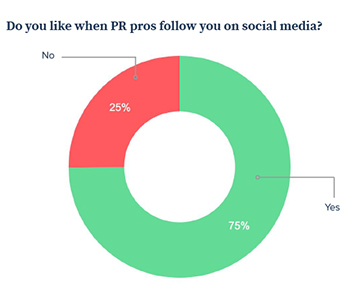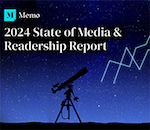 |
Twitter outpaces all other social networks among journalists surveyed for a new study from Muck Rack. However, online magazines and newspapers are still the dominant digital source when it comes to where journalists go to get their news.
Six in ten respondents (60 percent) in the “The State of Journalism 2020” study said that online publications are their primary source for news, with only five percent saying that they go to print magazines or newspapers first. Twitter was far and away the top social media source for news, with 22 percent of respondents naming it as their first choice for getting news. Facebook racked up a paltry two percent share.
Social media is also becoming increasingly important in helping journalists gather information. Almost six in ten (59 percent) say they either always or usually consult a company’s social media when reporting on it. However, 45 percent said they either “agree” or “strongly agree” that the way companies share information with the media is outdated.
 |
Three-quarters of journalists (75 percent) also say they want PR pros to follow them on social media. But that doesn’t mean they want to receive story pitches via social networks. Only seven percent said they like getting pitches through a social network, with 93 percent saying they like being pitched a story through a one-on-one email.
Twitter was the top choice when journalists were asked which social networks were most useful to them, with 85 percent naming it, up from 83 percent last year. Second-place Facebook was mentioned by 35 percent (down from last year’s 40 percent). LinkedIn (23 percent), Instagram (16 percent), Reddit (10 percent) and YouTube (nine percent) all lagged far behind.
Almost four in ten (38 percent) of the survey respondents said they planned to step up the amount of time they spend on Twitter over the next year. Only 12 percent said the same about Facebook, far below the number mentioned by LinkedIn (30 percent), Instagram (29 percent) and YouTube (22 percent). In addition, only two percent of respondents said they do not use or plan to use Twitter.
Most journalists (69 percent) also keep track of how many times their stories are shared on social media. When it comes to what they think makes a story more shareable, three characteristics come out on top: connection with a trending story (77 percent), containing an image (74 percent) and being easily made relevant or localized to a target audience (62 percent).
“The State of Journalism 2020” surveyed over 1,000 journalists in January and February of this year.


 Trump Media & Technology Group today reported a $58.2M net loss on $4.1M in 2023 revenues, a disclosure that drove its stock price down 22.6 percent to $47.96.
Trump Media & Technology Group today reported a $58.2M net loss on $4.1M in 2023 revenues, a disclosure that drove its stock price down 22.6 percent to $47.96. Barry Pollack, an attorney at Wall Street’s Harris St. Laurent & Wechsler, has registered Julian Assange as a client with the Justice Dept. “out of an abundance of caution.”
Barry Pollack, an attorney at Wall Street’s Harris St. Laurent & Wechsler, has registered Julian Assange as a client with the Justice Dept. “out of an abundance of caution.” Paramount Global to slash 800 jobs in what chief executive Bob Bakish calls part of an effort to “return the company to earnings growth"... Rolling Stone editor-in-chief Noah Shachtman is exiting at the end of the month due to disagreements with chief executive Gus Wenner over the direction the magazine is taking... The New York Times broke the $1 billion barrier in annual revenue from digital subscriptions in 2023... Press Forward is investing more than $500 million to strengthen local newsrooms.
Paramount Global to slash 800 jobs in what chief executive Bob Bakish calls part of an effort to “return the company to earnings growth"... Rolling Stone editor-in-chief Noah Shachtman is exiting at the end of the month due to disagreements with chief executive Gus Wenner over the direction the magazine is taking... The New York Times broke the $1 billion barrier in annual revenue from digital subscriptions in 2023... Press Forward is investing more than $500 million to strengthen local newsrooms. The majority of news articles are read within the first three days of publication, according to a recent report.
The majority of news articles are read within the first three days of publication, according to a recent report. The Los Angeles Times gives pink slips to 115 people or 20 percent of its newsroom staff... TIME is also laying off about 30 employees, which is approximately 15 percent of its editorial staff... The Baltimore Banner, which was launched by Stewart Bainum in 2022 after he failed to buy the Baltimore Sun, added 500 subscribers per day in the three days following Sinclair Broadcast Group's deal to purchase the Sun.
The Los Angeles Times gives pink slips to 115 people or 20 percent of its newsroom staff... TIME is also laying off about 30 employees, which is approximately 15 percent of its editorial staff... The Baltimore Banner, which was launched by Stewart Bainum in 2022 after he failed to buy the Baltimore Sun, added 500 subscribers per day in the three days following Sinclair Broadcast Group's deal to purchase the Sun.


 Have a comment? Send it to
Have a comment? Send it to 
No comments have been submitted for this story yet.